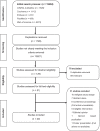Hand hygiene practices for prevention of health care-associated infections associated with admitted infectious patients in the emergency department: a systematic review
- PMID: 35435564
- PMCID: PMC10066077
- DOI: 10.1007/s11845-022-03004-y
Hand hygiene practices for prevention of health care-associated infections associated with admitted infectious patients in the emergency department: a systematic review
Abstract
Background: In most high-income countries, emergency departments (ED) represent the principal point of access forcer by critically ill or injured patients. Unlike inpatient units, ED healthcare workers (ED HCWs) have demonstrated relative lack of adherence to hand hygiene (HH) guidelines, commonly citing frequency of intervention and high rates of admission, which reflect severity of cases encountered.
Aim: Assessment of studies on hand hygiene compliance (HHC) by ED HCWs conducted between 2010 and 2020, seeking to estimate HHC rates and intervention strategies utilised to improve HHC in EDs.
Methods: Searches conducted in Web of Science, EBSCO HOST (CINHAL & Medline), PubMed, Embase, and Cochrane for full studies published between 2010 and 2020 on the topic of HHC in the ED.
Results: One hundred twenty-nine eligible articles were identified of which 79 were excluded. Fifty-one underwent full-text screening before 20 studies were deemed relevant. Of the eligible studies, fifteen (75%) had, as the primary outcome, HHC according to the WHO-recommended 5-moments. Twelve studies (60%) implemented multimodal or single intervention strategies. Eight studies were ambiguous regarding the nature of the approach adopted. In the nine observational studies where HHC was documented, an overall post-intervention median HHC rate of 45% (range 8-89.7%).
Conclusion: Multimodal approaches appear to have enhanced HHC moderately among ED HCWs. Elevated complexity associated with critically ill patients, and ED overcrowding, are contributing factors to relatively low compliance rates observed. Strategies to improve HHC rates may need to acknowledge, and cater for, the context of an unpredictable environment.
Keywords: Emergency department; HAI; HCAI; Hand hygiene; Hand hygiene compliance; Hand washing; Health care-associated infection; Hospital-acquired infection; Systematic review.
© 2022. The Author(s).
Conflict of interest statement
The authors declare no competing interests.
Figures
References
-
- WHO. Health care-associated infections-fact sheet. https://www.who.int/gpsc/country_work/gpsc_ccisc_fact_sheet_en.pdf. Accessed 4 Mar 2022
Publication types
MeSH terms
LinkOut - more resources
Full Text Sources
Medical


